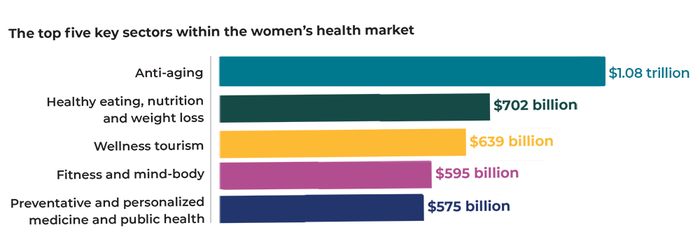.png?width=700&auto=webp&quality=80&disable=upscale)
'Centual' healing: How to appeal to female wellness consumers
As the most dominant lifestyle factor driving change in consumer behavior, wellness affects women's buying decisions for themselves and their families. Find out the best ways to attract these customers to your products and your store's shelves.
January 29, 2020

In 1998, wellness was a hot trend. Today, wellness is a cultural obligation, a powerful economic engine and a wellspring for vast market opportunities.
For more than two decades, wellness has been the single most dominant lifestyle factor driving change in consumer behavior, food and beverage culture, and product ideation, development and marketing. According to the Global Wellness Institute’s Global Wellness Economy Monitor, the global wellness economy was a $4.2 trillion market in 2017. The top five key sectors within this burgeoning market are personal care, beauty and anti-aging ($1.08 trillion); healthy eating, nutrition and weight loss ($702 billion); wellness tourism ($639 billion); fitness and mind-body ($595 billion); and preventative and personalized medicine and public health ($575 billion).
The Global Wellness Summit predicted that by 2028, women will control close to 75 percent of discretionary world spending. It’s no longer socially acceptable to be unconscious of one’s personal health and well-being. One must be well to be happy, fulfilled, fun, engaged, self-expressed and vibrant.
This responsibility to be well is felt most acutely by women, the wellness-keepers of our culture and the gateway to household spending for wellness products.
Historically, manufacturers and retailers have responded to wellness demand by providing a glut of better-for-me food and beverage health and wellness products. The explosion of wellness solutions in the marketplace has created serious competition for the attention of women. So, what’s the pathway to women wellness consumers?

Centuality
"Centuality" is a term coined by The Hartman Group more than a decade ago to summarize the three key criteria women use when choosing wellness products and services: fiscal responsibility (dollars and cents), the five senses, and common sense or logic.

Financial stability is integral to wellness, because worrying about money can be a major stressor. Women, especially those who do not have partners, worry if they have enough money to adequately care for themselves and their children today and certainly in the future, as well. College funds and retirement savings are chronic concerns, and women invest in wellness now out of fear they cannot afford to be unwell. Financially, women often do not have the option of not working due to illness. The ability to relax and enjoy emotional wellness hinges on a woman’s financial stability.
Takeaway: Communicate the value of personal health and wellness benefits, especially those attributes that help women feel good about themselves and reduce anxiety and stress.
Five senses
Quality is not always objective, but often resides in subjective perceptions. Women are especially attuned to how products smell, look, feel, taste and sound. Product packaging and retail environments are strong contributors to wellness product and service perceptions. Women enjoy aesthetics. They delight in attractive wrappers, boxes or bottles; aromas that stir the appetite or imagination; textures that beg a lingering touch; and, of course, taste that delivers on expectations. Women comment that sound is an important part of their wellness. This is often overlooked in product packaging and retail environments. The sound of silence, water, laughter and music contribute to feelings of well-being.
Takeaway: To speak to the female consumer, deliver more than words can say.
Common sense
When it comes to wellness, women are pragmatic and intuitive. If a solution, such as product or service, resonates on a gut level, they will be inclined to try it. For example, high-fiber cereal for weight management will make more sense to women than a high-fiber ice cream. Solutions need to be logical as women do not have the time to extensively consider the plethora of choices available to them.
Takeaway: Keep solutions and messaging simple and logical.
How this adds up
What health and wellness encompasses continuously grows as consumers gain more awareness of how factors big and small affect their quality of life. Wellness is a holistic pursuit for women, involving mind, body and spirit. Accordingly, women want products that speak to them at these points of connection. 'Centuality' is a guiding principle that manufacturers can use to appeal to the female wellness consumer.
Acknowledge women’s caregiving obligations and their keen sense of financial responsibility. The woman wellness consumer is savvy, not miserly. Communicate value as quality rather than price. Quality is conveyed by retail environment aesthetics and knowledgeable service, product ingredients, packaging, messaging and communications. Cues should be in overall alignment since disjointed themes will undermine quality perceptions. It is important to note the retail environment and the product have a mutual role in defining the other’s quality halo. Manufacturers and retailers should consider working in close partnership as each pursues innovations, because women consumers do not consider a product’s merits independently.
Wellness must make sense to women, and simplicity is the key. Solutions or retail experiences that are too complicated will create frustration and stress rather than calm and satisfaction. Overly scientific formulations, long ingredient lists, busy packaging, crowded aisles, obtrusive shelf danglers and incongruent merchandising (such as hair bands next to produce) all serve to perplex the consumer. Simplicity cues quality, and women will pay more for high quality wellness products that intuitively work with their holistic wellness perspective. It must pass the "common sense" test.
With Centuality as a guiding principle, manufacturers can proceed with confidence that they are capturing the attention of the primary wellness consumer: women. If they recognize a brand is speaking to them from a point of empathy, they will be loyal.
As The Hartman Group CEO, Laurie Demeritt drives the vision, strategy, operations and results-oriented culture for the company’s associates as it furthers its offerings of tactical thinking, consumer and market intelligence, cultural competency and innovative intellectual capital to a global marketplace.

About the Author(s)
You May Also Like




